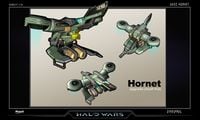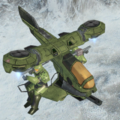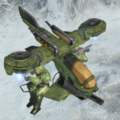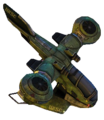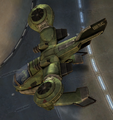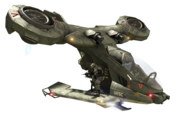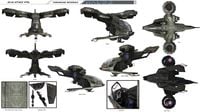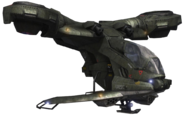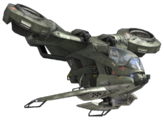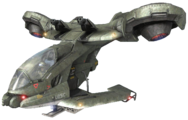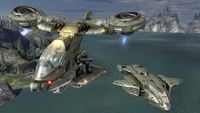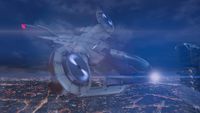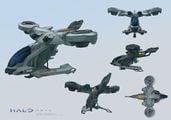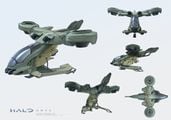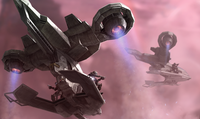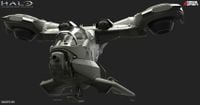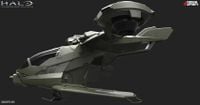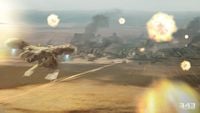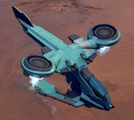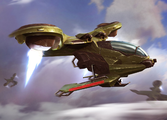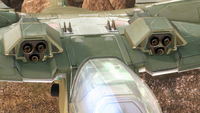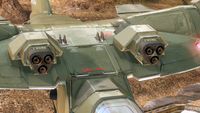AV-14 Hornet
From Halopedia, the Halo wiki
| AV-14 Attack VTOL | |
|---|---|
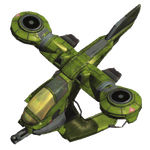 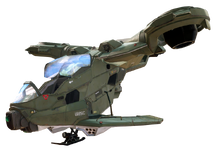 The AV-14 (top) and AV-14B (bottom) variants of the Hornet. The AV-14 (top) and AV-14B (bottom) variants of the Hornet.
| |
| Production information | |
|
Manufacturer: |
|
| Technical specifications | |
|
Length: |
|
|
Width: |
|
|
Height: |
4.5 meters (14.6 ft)[2] |
|
Mass: |
3.7 metric tons (3.6 LT; 4.1 ST)[2] |
|
Engine(s): |
|
|
Armament: |
|
|
Crew: |
|
|
Complement: |
|
| Usage | |
|
Affiliation: |
|
The AV-14 Attack VTOL,[1][2] or Attack VTOL-14[3][6] (colloquially nicknamed the Hornet), is a VTOL attack aerodyne manufactured by Misriah Armory.[2]
Overview[edit]
Design details[edit]
The Hornet is a multi-purpose attack aerodyne similar to other craft like the AV-19 SkyHawk, AV-22 Sparrowhawk, AV-30 Kestrel and AV-49 Wasp. It is generally used for combat reconnaissance, close-air support, covert infantry insertions, and air strikes against isolated targets.[2] It is capable of engaging both ground and air targets, making it capable in a variety of circumstances.[1]
Hornets are particularly compact aircraft that pack a single-pilot[1][2] cockpit (twin-seater in tandem configuration on some variants, see below)[4], two skids capable of seating up to four passengers, and a variety of weapon systems into a frame measuring 9.6 meters (31.4 ft) in length.[1][2] Above and to the aft of the cockpit are a set of wings fitted with what appear to be advanced turbofan engines mounted on a set of gimbles. The turbofans are able to rotate around, providing the Hornet with its primary propulsion and making it fairly agile to manoeuvre.
A landing skid is placed on either side of the main fuselage. The skids each contain a single crash seat though are each able to support up to two embarked infantry, or four total per-craft. This lets the Hornet act as an impromptu troop transport for deploying small teams of infantry in a covert manner, though the infantry themselves are unprotected from incoming counterfire.[2] However, infantry embarked on the skids can contribute their own weaponry to the Hornet's defence; this commonly manifests in the form of wingmen armed with M41 SPNKr rocket launchers, which are able to enhance the Hornet's anti-tank and anti-air capabilities.[8][9] Alternatively, the Hornet can be used as a mobile platform to host a sniper armed with an anti-materiel weapon such as an SRS99-AM sniper rifle or M99 Stanchion.[10]
There are over a dozen distinct Hornet variants in active production,[2] though the two most prolific are the AV-14 and AV-14B. They differ primarily in the type, number, and placement of their machine gun weaponry.
Armaments[edit]
The armament equipped by the Hornet differs depending on the model. The standard AV-14 loadout consists of a single long-barrelled 20mm GAU-23/AW/Linkless Feed Autocannon fitted to the nose of the craft,[3][11] alongside twin M651 missile launchers affixed to the landing skids.[6][9] The M651s fire M5607 Automatic Self-Guiding Missile-4s. These are the same missiles as fired by the LAU-65D/SGM-151 missile pod.[Note 1]
The most commonly-used and heavily-outfitted variant is the AV-14B, a Hornet used in ground and air support operations. The AV-14B is fitted with twin fire-linked short-barrel 20mm GAU-23/A rotary cannons situated above the cockpit, alongside the standard M651 missiles.[2]
Sensors and defenses[edit]
The Hornet's nose contains a camera and sensor system, alongside a floodlight.[7] The vehicle has long-ranged optics and infrared sensors.[12] On standard AV-14 models, chaff pods can be affixed to the top of the airframe, slotting into the port occupied by the twin rotary cannons on the AV-14B.[9] Hornets are not equipped with any form of energy shielding and only light armour, making them susceptible to anything heavier than small-arms fire.[8][13][14]
Variants[edit]
Over a dozen Hornet variants are manufactured by Misriah Armory, seeing service in civilian, law enforcement, government, and military sectors.[2]
- AV-14 Hornet[Note 2]: standard model, boasting M651 missile pods in the skids and a single GAU/23/A autocannon mounted on the nose.[9][11]
- AV-14B Hornet: the most commonly-seen Hornet variant, boasting twin GAU/23s and twin M651 missile pods.[8][15]
- Trooper Hornet: a modified AV-14B Hornet design built by the forces of UNSC Spirit of Fire operating on the Ark. The Trooper variant boasts dazzle camouflage and an up-armoured housing.[15]
- Transport Hornet: a modified AV-14B that lacks the missile launchers, intended for troop transport and light air support duties.[16]
- NMPD Hornet: a law enforcement Hornet variant used by the New Mombasa Police Department. Similarly to the Transport Hornet, the NMPD variant lacks missile launchers. Similarly to the D77C Pelican it boasts a black/white paint scheme and emergency lights.[17]
- Tandem-seater Hornet: an unidentified variant visually reminiscent of the AV-14B, but featuring tandem seating allowing for two operators to sit in the cockpit as opposed to the standard model's one.[4]
A standard AV-14 Hornet.[Note 2]
A Hornet boasting tandem seating, allowing for a co-pilot in the cockpit.[4]
In-game information[edit]
- Main article: Hornet
The Hornet was introduced into the Halo series in Halo 3, becoming the first drivable UNSC aircraft in the series' history. It was later featured in the multiplayer component of Halo 2: Anniversary and the strategy games Halo Wars and Halo Wars 2. It was replaced by the Falcon and Wasp in subsequent titles.
Halo Wars 2[edit]
Phoenix Log[edit]
|
Fast. nimble, multi-role attack VTOL. Hornets are fast-attack aerial gunships used for combat reconnaissance and lightning strikes against high-priority targets. They are armed with rotary autocannons that are effective against all targets and can be upgraded with Marine Wingmen carrying rocket launchers. Air operation directors from the Spirit of Fire are fond of the AV-14B Hornet's firepower, but they are also very much aware of the vehicle's relative fragility. Marine pilots often mitigate this issue by operating in Hornet "wolfpack" kill teams to overwhelm air defenses and destroy their targets before retaliatory fire can do much damage. Commanders are advised to wait for the SPNKR-armed wingmen and personally direct the assault when using Hornet swarms against heavily defended facilities. |
Production notes[edit]
Early origins[edit]
- Main articles: Cut Halo 2 vehicles § Falcon, Cut Halo 3 vehicles § Falcon
The Hornet was introduced into Halo in Halo 3. However, its origin lies in a vehicle cut from Halo 2: the Falcon (not to be confused with the utility helicopter later introduced in Halo: Reach). The Falcon was the brainchild of Marcus Lehto, who pushed for the inclusion of a UNSC aircraft as early as the Kestrel in Halo: Combat Evolved. Lehto envisioned the Falcon for Halo 2 as a single-pilot attack VTOL capable of carrying a handful of infantry, allowing it to serve as the "Warthog of the skies". The Falcon was ultimately cut from Halo 2, with Lehto instead using it as the basis for a vehicle for Halo 3. Early concepts for Halo 3 depicted a vehicle more similar to a helicopter or Pelican dropship with side doors that could carry infantry, though these later evolved into a form more familiar to players of the final game. One notable mid-stage concept produced by Isaac Hannaford had a gunner seat situated on the back of the Hornet, though this was not featured in the final game.
An early sketch for Halo 3, by Lehto. Note the introduction of the Hornet's silhouette.[18]
Model designation[edit]
The AV-14B's designation primarily comes from Halo Wars 2 and its supporting material.[8][15] These sources appear to draw a deliberate difference between the Hornet design featured in Halo 3, Halo 4, and Halo Wars 2 presumably from the one featured in the original Halo Wars - the latter of which has a slightly altered armament and design features.
Trivia[edit]
In Halo Wars 2, the Hornet's pilot was voiced by Morla Gorrondona, who also provided the voice for Kwon in Halo: Spartan Strike and Zhao Heng Lopez in The Mona Lisa.[21][22]
Gallery[edit]

|
Browse more images in this article's gallery page. |
AV-14 (Halo Wars design)[edit]
AV-14B (Halo 3, Halo 2: Anniversary, and Halo Wars 2 design)[edit]
A flight of Hornets deploy ODSTs into the occupied city of Cleveland on Earth in 2552 in Halo: Uprising.
A pilotless Hornet as a scenery object on Icebox.
A squadron of Hornets pursue Covenant forces during the Battle of Draetheus V.
A Hornet flying towards a city in Halo: Spartan Strike.
An AV-14B Hornet in the Halo Wars 2 Open Beta.
Title card art from a cut Halo Wars 2 mission featuring AV-14B Hornets and an AC-220 Vulture.
Blitz artwork for the Hornet.
A Hornet falls to the surface of an agricultural region on a human colony during the Insurrection.
List of appearances[edit]
- Halo: Uprising (First appearance)
- Halo 3
- Halo: Contact Harvest
- Halo Wars
- Halo 3: ODST (Halo: The Master Chief Collection only)
- Halo Legends
- Halo: Evolutions - Essential Tales of the Halo Universe
- Halo 4 (Background only)
- Halo: Spartan Assault
- Halo: Mortal Dictata (Mentioned only)
- Halo 2: Anniversary
- Halo: Spartan Strike
- Halo: Last Light (Mentioned only)
- Halo 5: Guardians (Mentioned only)
- Halo Wars 2
- Halo: Legacy of Onyx
- Halo: Divine Wind
- Become
- Halo: Anvil Accord (Mentioned only)
Notes[edit]
- ^ See M651 production notes
- ^ a b See production notes
Sources[edit]
- ^ a b c d e f g h i Halo: The Essential Visual Guide, page 96
- ^ a b c d e f g h i j k l m n o p q r Halo Encyclopedia (2022 edition), page 157: While the page caption does not specifically call out the AV-14B, the AV-14B is pictured and discussed.
- ^ a b c Halo Wars: Official Strategy Guide, page 45
- ^ a b c d Halo Legends - Homecoming
- ^ Halo: Last Light, chapter 14
- ^ a b Official Halo Wars Community Site, Hornet (Retrieved on Feb 18, 2011) [local archive] [external archive]
- ^ a b Halo 4, multiplayer map Skyline
- ^ a b c d Halo Wars 2, Phoenix Logs: Hornet
- ^ a b c d Halo Wars, Hornet in-game unit
- ^ Halo: Contact Harvest, Prologue
- ^ a b Halo: Evolutions - Dirt
- ^ Halo: Divine Wind, chapter 4
- ^ Halo Encyclopedia (2009 edition), page 248
- ^ Halo Encyclopedia (2011 edition), page 258
- ^ a b c Halo Waypoint, Canon Fodder - The Art of War(s) (Retrieved on Mar 19, 2017) [archive]
- ^ Bungie.net, Bungie Weekly Update: 3/14/08 (Retrieved on Oct 12, 2014) [archive]
- ^ MEGA Construx, Police Air Support Hornet (97429) (Retrieved on Mar 9, 2021) [archive]
- ^ Twitter, Marcus Lehto (@game_fabricator): "Just found this old sketch idea from one of my books between Halo2 and Halo3. Falcon design brainstorm I believe. Trying to cram the Warhog in there somehow." (Retrieved on Jul 18, 2022) [archive]
- ^ The Art of Halo 3, page 45
- ^ Halo Encyclopedia (2011 edition), page 64
- ^ X.com, Morla Gorrondona (@actor_morla): "Congrats 343i & @CAGames - Happy #halowars2 Launch Day! Proud to be your Hornet!" (Retrieved on Dec 7, 2024) [archive]
- ^ X.com, Morla Gorrondona (@actor_morla): "Hey @sharkgirl09 - I'm Lt. Kwon in Halo: Spartan Strike & Sgt. Lopez in Halo: Mona Lisa." (Retrieved on Dec 7, 2024) [archive]
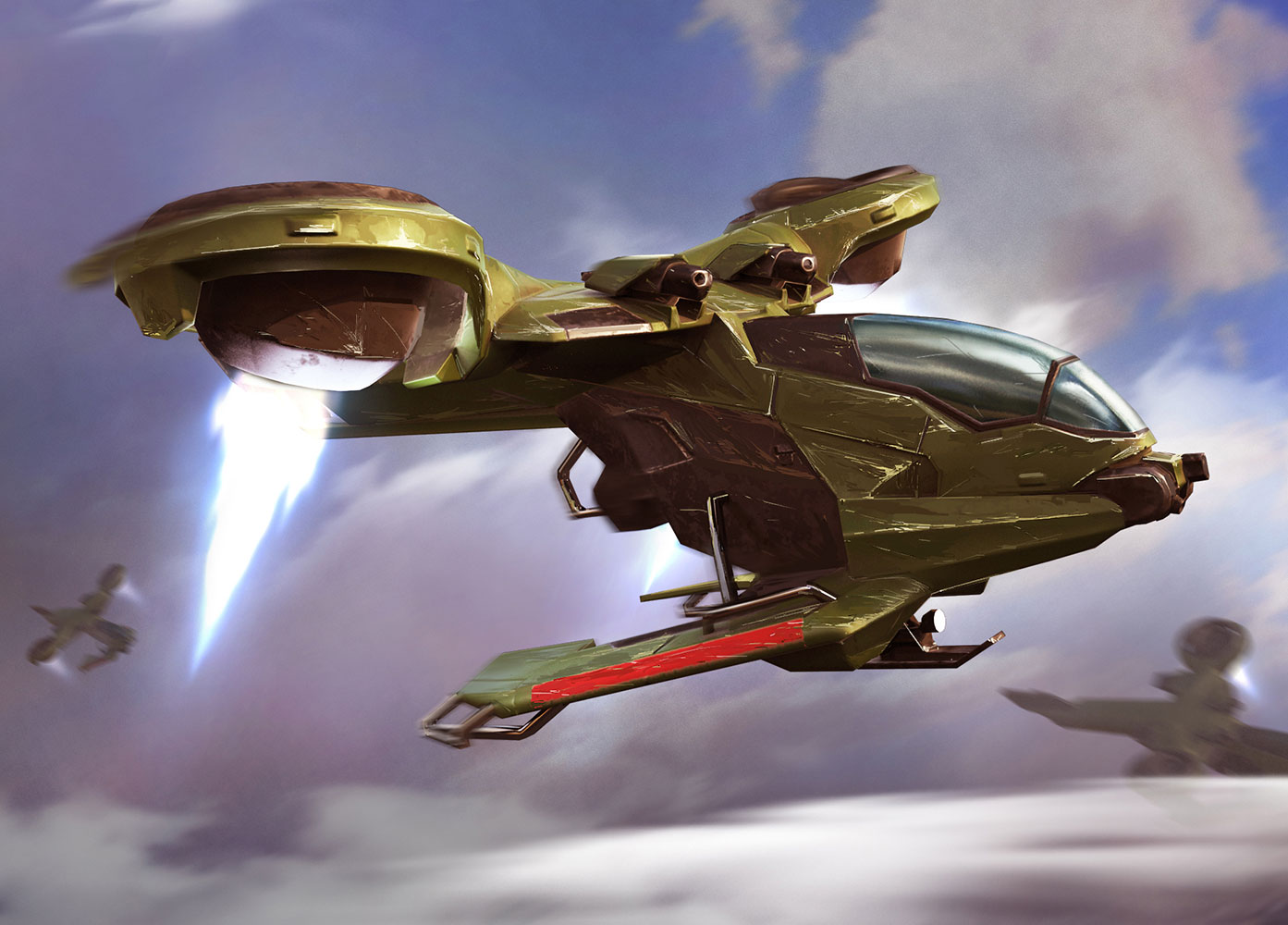


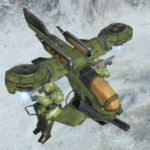
![A standard AV-14 Hornet.[Note 2]](https://halo.wiki.gallery/images/thumb/f/fe/HW-AV14.png/120px-HW-AV14.png)
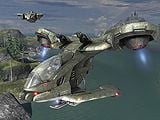
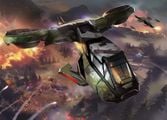
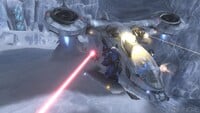
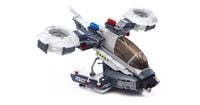
![A Hornet boasting tandem seating, allowing for a co-pilot in the cockpit.[4]](https://halo.wiki.gallery/images/thumb/b/bc/Homecoming_Hornet_Concept.png/200px-Homecoming_Hornet_Concept.png)


![An early sketch for Halo 3, by Lehto. Note the introduction of the Hornet's silhouette.[18]](https://halo.wiki.gallery/images/thumb/4/4c/Early_Falcon_Concept.jpg/200px-Early_Falcon_Concept.jpg)
![Halo 3 concept artwork by Isaac Hannaford,[19] later featured in the 2009 and 2011 Halo Encyclopedias.[20]](https://halo.wiki.gallery/images/thumb/9/99/H3_Falcon_Concept.png/141px-H3_Falcon_Concept.png)

